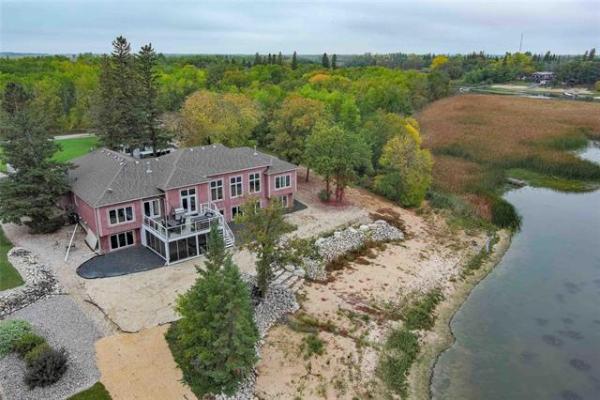Homebuyers searching for their next property are more likely than ever to purchase a house that also comes with a garden. Attractively developed landscapes add considerable value to the worth of a property.
What if you are selling your home and facing the prospect of leaving your beautiful garden behind? Is it possible to take your favourite plants with you?
Terie Langen, a busy realtor with Re/Max Winnipeg, says that she has yet to meet a gardener in her 20-plus years of residential home selling who does not bring up the question of keeping some favourite plants.
"The multiple listing contract used in Manitoba," explained Langen, "allows for public notification of exclusions to the sale of a home. Generally, it is disclosed up front that some perennials or cuttings will be taken from the yard."
Langen says the garden would be considered a fixture assumed to be part of a homebuyer's purchase. "Disclosure and discretion in quantity removed would be the way to address any favourites," said Langen.
This is good news for gardeners who can't bear to leave behind a magnificent, mature hosta, rare specimen or any plant that has special significance.
What would you dig up and take with you if you were moving away from your garden? I would take my Casa Blanca lilies. And probably a few clumps of my Brunnera macrophylla, too. Of course, I would dig up my Twist 'n Shout lacecap hydrangeas and every one of my dark violet blue Dracocephalum grandiflorum (Dragon's Head).
Yes, I can see where this is going so I will stay where I am. However, for gardeners who, for whatever reason, are contemplating a move, it is indeed possible to take some of your favourite plants with you.
Maurice Larson tends the largest garden in all of Winnipeg. As supervisor of outdoor gardens at Assiniboine Park, Larson has relocated many plants over the years.
"In my experience, plants are very resilient," said Larson who stresses that it is the attention to detail by the gardener both at the time of digging and replanting, and in particular, the aftercare that determines the success of the relocation.
Before Eileen Rosen moved, visitors would stop by her shady River Heights garden and marvel at the collection of plants that she had so carefully assembled and arranged over the years. With the discerning eye of the interior designer that she is, Rosen understands the effective use of colour and texture. When the decision was made to switch from a two-storey home to a bungalow, Rosen readied her wheelbarrow, made her list, confirmed it with her realtor and commenced digging in early spring.
The task was daunting but not only because digging is strenuous work. Rosen's new landscape was nowhere near ready to accept new transplants. The previous owners of her newly purchased property were not gardeners. Instead of a manicured landscape with deep beds awaiting her mature perennials, Rosen's new property was a dense thicket of dead and dying oak trees. And in the centre of it all, one massive cottonwood tree.
In all, close to 20 trees, including the cottonwood, were removed from Rosen's new landscape. Rosen left three oak trees but they became stressed and started dying because the water table had been altered with the removal of so many trees.
To complicate matters, Rosen's next-door neighbour had built up his property significantly and runoff water drained into the side of her yard.
"Basically my yard was like a drainage ditch," admitted Rosen, her great sense of humour intact.
Although she liked the size of the yard and the opportunity to develop a new garden, she knew it was going to be a tremendous amount of work. The rows of pots providing temporary housing to the scores of plants that she brought from her previous garden provided the inspiration she needed to get the job done.
With the tree removal behind her, Rosen called Samborski's Garden Supplies and ordered 35 yards of quality soil.
Rosen pulled out thistles and burdock and then set about preparing her new beds. The first step was to cover the soil with layers of newspapers, overlapping the edges. This practice succeeds in blocking out all light and killing existing weeds. Next she heaped Samborski's five-way soil on top. The thoroughbred yard and garden mix contains no peat moss, only black soil, manure, 2 mm fine sand, compost and Elm Creek Soil, said to be the best sandy loam soil in southern Manitoba.
This is the fourth summer since that momentous move and yet Rosen's new garden has the look of a mature garden at its height of glory. What did she bring with her from her previous garden? She knew from the start that she would not be leaving her catalpa tree behind. When Rosen dug it up four years ago, it was only 1.8-meters tall. Today, dripping with long slender seedpods, it has claimed centre spot in one of the flower beds and has grown past the telephone wires.
Other relocated plants include geranium Rozanne, David phlox, martagon lilies, Red Velvet Asiatic lily, Misty Mauve delphinium, ornamental rhubarb, three Itoh peonies, a simply spectacular meadow rue, monkshood, giant fleece flower, Sum and Substance hosta, Beauty of Cobham monarda and some favourite lilies, Cinnamon Roll and Hyperion.
Of course that's not all. Rosen also dug up grasses including Molinia Skyracer, Panicum Virgatum Heavy Metal and fussy Hakonechloa macra (Japanese forest grass). The latter took two years to adjust to its new site but is now thriving.
Rosen brought along two hydrangeas as well: Incrediball and a lesser known variety, White Dome.
Rosen was very selective with the plants she chose. "You don't know the drainage patterns or the light conditions of a new garden," said Rosen. Keeping your transplants in their pots and moving them to various locations helps you to decide on the perfect spot for planting.
When Darlene Belton moved from her fully developed sun-filled landscape in East Fort Garry to a shady yard in Charleswood last year, she also faced a challenging new landscape, one that consisted mainly of weeds and a few struggling shrubs. Belton was fortunate enough to be able to ready her new beds in the fall prior to taking possession. A permaculture devotee, Belton used the lasagna method, layering organic material (grass clippings and leaves) for a rich organic base.
With full approval of Joan Sikorsky, the new buyer of her Fort Garry property, Belton began dividing plants, taking half of each to her new garden and leaving the other half for Sikorsky. Interestingly, Belton's new shady landscape proved beneficial to many of her plants, including bugbane (Cimicifuga ramose), bergenia and hostas as well as two shrubs, nannyberry and Morden amber dogwood.
Some of Belton's plants were making their second move, having travelled some years ago from Kingston to Winnipeg in the back seat of a car, a trip that took three days in the heat of August. Still, the plants had to wait until the following spring before being replanted and spent the winter in their pots under mounds of leaves and snow cover.
When digging up her plants last spring, Belton dug up as much of the root ball as possible, popped them in pots twice the size of the rootball so as to minimize transplant shock and backfilled with soil from the bed, tamping each plant down securely and watering thoroughly. Today, she is perfectly happy with her new landscape, filled with healthy plant divisions.
Jan Pedersen, sales representative with Bylands Nurseries, once moved three six-year-old Globe blue spruce trees from one garden to the next. Anticipating the size of the root ball, Pedersen chose a 15 gallon container size and dug the trees up by hand.
"You're removing the tree from its main feeding roots because the feeder roots go much beyond what you can dig," said Pedersen who immediately fed each tree, once they were placed in the containers, with a liquid root inducing fertilizer.
Destined for his new garden, the effort was backbreaking but worth it since the evergreens were beautifully shaped and expensive to replace. Pedersen had the permission of the new buyer of the home and left smaller plants in their place. The evergreens were stored over the winter at his parents' place in a protected corner with good snow cover.
Pedersen says he wouldn't move a deciduous tree with a trunk larger than 25 mm in diameter. "It might be wiser to invest in a new tree," said Pedersen who also recommends late September or October is a good time to dig up anything deciduous since there is enough frost to set dormancy.
Larson says anything with a taproot will have a higher level of difficulty to transplant. Balloon flower, asclepia, some of the spurges and poppies have tap roots and can be difficult plants. Potting plants immediately after digging helps to reduce their stress. Larson suggests some root pruning as well as trimming back the plant to reduce the risk of transplant shock.
As bittersweet as it may be to leave a garden, there is the opportunity to relocate prized plants and to create new and exciting combinations. Larson says site preparation is critical for continued success and recommends ensuring transplants are planted into a very well prepared area.
And what plant would Larson never leave behind? Clematis Recta, a fragrant ground clematis with showy white blooms.



